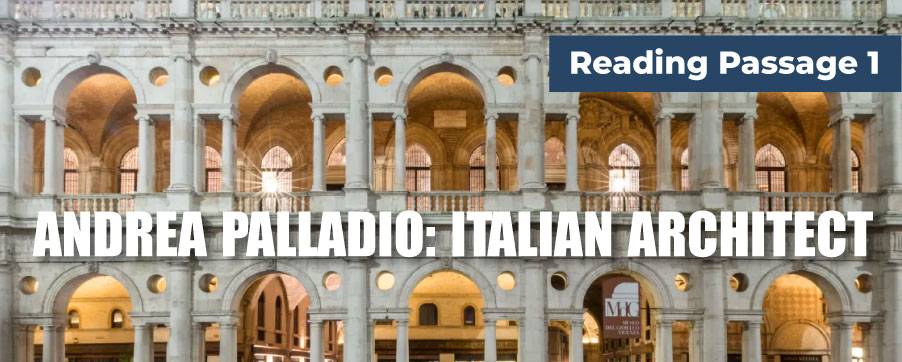
IELTS Recent Mock Tests Volume 4
- Đăng ngày: 29 Nov 2017
- Tests taken: 1,174,568
Đáp án
Part 1: Question 1 - 13
- 1 NOT GIVEN
- 2 TRUE
- 3 FALSE
- 4 NOT GIVEN
- 5 FALSE
- 6 TRUE
- 7 TRUE
- 8 (skilled) stonemason
- 9 Gian Giorgio Trissino
- 10 Inigo Jones
- 11 temple (architecture)
- 12 Quattro Libri dell’ Architettura
- 13 benevolent calm
- 1 NOT GIVEN
- 2 TRUE
- 3 FALSE
- 4 NOT GIVEN
- 5 FALSE
- 6 TRUE
- 7 TRUE
- 8 (skilled) stonemason
- 9 Gian Giorgio Trissino
- 10 Inigo Jones
- 11 temple (architecture)
- 12 Quattro Libri dell’ Architettura
- 13 benevolent calm
Part 2: Question 14 - 26
- 14 v
- 15 viii
- 16 vi
- 17 vii
- 18 iii
- 19 i
- 20 ii
- 21 equal opportunity
- 22 internal costs
- 23 C
- 24 C
- 25 A
- 26 B
- 14 v
- 15 viii
- 16 vi
- 17 vii
- 18 iii
- 19 i
- 20 ii
- 21 equal opportunity
- 22 internal costs
- 23 C
- 24 C
- 25 A
- 26 B
Part 3: Question 27 - 40
- 27 C
- 28 A
- 29 B
- 30 D
- 31 I
- 32 D
- 33 J
- 34 F
- 35 C
- 36 YES
- 37 NO
- 38 NOT GIVEN
- 39 NOT GIVEN
- 40 YES
- 27 C
- 28 A
- 29 B
- 30 D
- 31 I
- 32 D
- 33 J
- 34 F
- 35 C
- 36 YES
- 37 NO
- 38 NOT GIVEN
- 39 NOT GIVEN
- 40 YES
Leaderboard:
| # | Thành viên | Điểm | Thời gian | |
|---|---|---|---|---|
| thanhson0145 |  | 9.0 | 15:13 | |
| BARAKAT AKINPELU |  | 9.0 | 15:47 | |
| Nguyen Duc Kien |  | 9.0 | 15:59 | |
| 4 | Anindi K |  | 9.0 | 16:10 |
| 5 | Polina Kruk |  | 9.0 | 16:12 |
| 6 | Tariqur Rahman |  | 9.0 | 16:14 |
| 7 | sonam rinchen |  | 9.0 | 16:33 |
| 8 | zheng yang |  | 9.0 | 16:50 |
| 9 | Thanh Khiet |  | 9.0 | 17:55 |
| 10 | Khanh Nam |  | 9.0 | 18:26 |
Giải thích chi tiết
Question 1-7
Do the following statements agree with the information given in Reading Passage 1?
In boxes 1-7 on your answer sheet, write
| TRUE | if the statement agrees with the information |
| FALSE | if the statement contradicts the information |
| NOT GIVEN | If there is no information on this |
1 The building where the exhibition is staged has been newly renovated.
2 Palazzo Barbaran da Porto typically represents the Palladio’s design.
3 Palladio’s father worked as an architect.
4 Palladio’s family refused to pay for his architectural studies.
5 Palladio’s alternative design for the Ducal Palace in Venice was based on an English building.
6 Palladio designed for both wealthy and poor people.
7 The exhibition includes paintings of people by famous artists.
- 1 Answer: NOT GIVEN
Q1:
Question statement: The building where the exhibition is staged has been newly renovated.
Although the passage does mention Palazzo Barbaran da Porto as a building where the exhibition is held, we could not find any information implying that it has been newly renovated. So the answer is NOT GIVEN.
- 2 Answer: TRUE
Keywords in Questions
Similar words in Passage
Q2:.Palazzo Barbaran da Porto typically represents the Palladio’s design.
The exhibition has the special advantage of being held in one of Palladio’s buildings, Palazzo Barbaran da Porto. Its bold facade is a mixture of rustication and decoration set between two rows of elegant columns. On the second floor the pediments arc alternately curved or pointed, a Palladian trademark.
Q2: The text describes what the Palazzo Barbaran da Porto looks like and confirmed that its design is the Palladian trademark. => The answer is True.
- 3 Answer: FALSE
Keywords in Questions
Similar words in Passage
Q3: Palladio’s father worked as an architect
Palladio’s father was a miller who settled in Vicenza.
Q3: The text confirms the job of Palladio’s father is a miller, not an architect => The answer is False.
- 4 Answer: NOT GIVEN
Q4:
Question statement: Palladio's family refused to pay for his architectural studies.
The passage does mention a rich patron named Gian Giorgio Trissino organised Palladio's education, but we could not find any information implying that his family didn't want to pay for his studies. Therefore, the answer is NOT GIVEN.
- 5 Answer: FALSE
Keywords in Questions
Similar words in Passage
Q5: Palladio’s alternative design for the Ducal Palace in Venice was based on an English building.
after a fire at the Ducal Palace, he offered an alternative design which bears an uncanny resemblance to the Banqueting House in Whitehall in London.
Q5: While being based on the Banqueting House in Whitehall in London means that it was built first then Palladio’s alternative design took it as a model to follow, bearing an uncanny resemblance to the English building means that the two buildings shared the same appearance => The answer is False.
- 6 Answer: TRUE
Keywords in Questions
Similar words in Passage
Q6: Palladio designed for both wealthy and poor people.
Palladio’s work for rich landowner alienates unreconstructed critics on the Italian left but among the papers in the show are designs for cheap housing in Venice.
Q6: In this paragraph, the sentence: ”Palladio’s work for rich landowner alienates unreconstructed critics on the Italian left but among the papers in the show are designs for cheap housing in Venice.” does mention Palladio’s work for rich landowner (or the rich like in the question statement) and his designs for cheap housing (which was aimed for the poor). So the given statement is True.
- 7 Answer: TRUE
Keywords in Questions
Similar words in Passage
Q7: The exhibition includes paintings of people by famous artists.
Vicenza’s show contains detailed models of the major buildings and is leavened by portraits of Palladio’s teachers and clients by Titian, Veronese and Tintoretto; the paintings of his Venetia buildings are all by Canaletto, no less.
Q7: The first sentence of this paragraph does mention all the keywords list above (exhibition = Vicenza’s show; include = contain; paintings of people = portraits of Palladio’s teachers and clients; famous artists = Titian, Veronese and Tintoretto), so the given statement is confirmed. The answer is True.
Questions 8-13
Complete the sentences below.
Choose NO MORE THAN FOUR WORDS from the passage for each answer.
Write your answers in boxes 8-13 on your answer sheet.
What job was Palladio training for before he became an architect?
8
Who arranged Palladio’s architectural studies?
9
Who was the first non-Italian architect influenced by Palladio?
10
What type of Ancient Roman buildings most heavily influenced Palladio’s work?
11
What did Palladio write that strengthened his reputation?
12
In the writer’s opinion, what feeling will visitors to the exhibition experience?
13
- 8 Answer: (skilled) stonemason
Keywords in Questions
Similar words in Passage
Q8: What job was Palladio training for before he became an architect?
where the young Andrea was apprenticed to a skilled stonemason
Q8:
Obviously, the answer must be a Noun, a kind of career.
The time stated in the question is before he became an architect, so we must find out his childhood job. Take a look at this text : ”where the young Andrea was apprenticed to a skilled stonemason”, here we have "young Andrea" has the same meaning as "Palladio in his childhood" => The answer is stonemason .
- 9 Answer: Gian Giorgio Trissino
Keywords in Questions
Similar words in Passage
Q9: Who arranged Palladio’s architectural studies?
Gian Giorgio Trissino, a landowner and scholar, who organised his education
Q9:
Here we must find a name of a person who helped Palladio’s architectural studies.
The text: “Gian Giorgio Trissino, a landowner and scholar, who organised his education” shows us that Gian Giorgio Trissino is the name of the person we are looking for. The answer is Gian Giorgio Trissino.
- 10 Answer: Inigo Jones
Keywords in Questions
Similar words in Passage
Q10: Who was the first non-Italian architect influenced by Palladio?
Inigo Jones, Palladio’s first foreign disciple
Q10:
Obviously, the answer must be a name of a person, he or she was the first non-Italian architect influenced by Palladio.
The text: “Inigo Jones, Palladio’s first foreign disciple” shows us that Inigo Jones is the name of the person we are looking for. The answer is Inigo Jones.
- 11 Answer: temple (architecture)
Keywords in Questions
Similar words in Passage
Q11: What type of Ancient Roman buildings most heavily influenced Palladio’s work?
What they show is how Palladio drew on the buildings of ancient Rome as models. The major theme of both his rural and urban building was temple architecture
The text: “What they show is how Palladio drew on the buildings of ancient Rome as models. The major theme of both his rural and urban building was temple architecture” contains all the keywords in the question, hence it shows us that temple architecture is the answer for this question.
- 12 Answer: Quattro Libri dell’ Architettura
Keywords in Questions
Similar words in Passage
Q12: What did Palladio write that strengthened his reputation?
Palladio’s reputation has been nurtured by a text he wrote and illustrated, “Quattro Libri dell’ Architettura”.
Obviously, the answer must be a phrase written by Palladio, which strengthened his reputation.
We could easily point out the answer appearing in the text above. It is Quattro Libri dell’ Architettura.
- 13 Answer: benevolent calm
Keywords in Questions
Similar words in Passage
Q13: In the writer’s opinion, what feeling will visitors to the exhibition experience?
but the impact of harmonious lines and satisfying proportions is to impart in a viewer a feeling of benevolent calm.
The question asks us about the feeling of the visitors experiencing the exhibition.
The text: “but the impact of harmonious lines and satisfying proportions is to impart in a viewer a feeling of benevolent calm.” does contains all the question’s keywords. We could easily find out the correct answer of this question. It is benevolent calm.
READING PASSAGE 1
You should spend about 20 minutes on Questions 1-13, which are based on Reading Passage 1 below.

Andrea Palladio: Italian Architect
A new exhibition celebrates Palladio’s architecture 500 years on.
Vicenza is a pleasant, prosperous city in the Veneto, 60 km west of Venice. Its grand families settled and farmed the area from the 16th century. But its principal claim to fame is Andrea Palladio, who is such an influential architect that a neoclassical style is known as Palladian. The city is a permanent exhibition of some of his finest buildings, and as he was born — in Padua, to be precise — 500 years ago, the International Centre for the Study of Palladio’s Architecture has an excellent excuse for mounting la grande mostra, the big show.
The exhibition has the special advantage of being held in one of Palladio’s buildings, Palazzo Barbaran da Porto. Its bold facade is a mixture of rustication and decoration set between two rows of elegant columns. On the second floor the pediments arc alternately curved or pointed, a Palladian trademark. The harmonious proportions of the atrium at the entrance lead through to a dramatic interior of fine fireplaces and painted ceilings. Palladio’s design is simple, clear and not over-crowded. The show has been organised on the same principles, according to Howard Bums, the architectural historian who co-curated it.
Palladio’s father was a miller who settled in Vicenza, where the young Andrea was apprenticed to a skilled stonemason. How did a humble miller’s son become a world renowned architect? The answer in the exhibition is that, as a young man, Palladio excelled at carving decorative stonework on columns, doorways and fireplaces. He was plainly intelligent, and lucky enough to come across a rich patron, Gian Giorgio Trissino, a landowner and scholar, who organised his education, taking him to Rome in the 1540s, where he studied the masterpieces of classical Roman and Greek architecture and the work of other influential architects of the time, such as Donato Bramante and Raphael.
Burns argues that social mobility was also important. Entrepreneurs, prosperous from agriculture in the Veneto, commissioned the promising local architect to design their country villas and their urban mansions. In Venice the aristocracy were anxious to co-opt talented artists, and Palladio was given the chance to design the buildings that have made him famous – the churches of San Giorgio Maggiore and the Redentore, both easy to admire because the can be seen from the city’s historical centre across a stretch of water.
He tried his hand at bridges — his unbuilt version of the Rialto Bridge was decorated with the large pediment and columns of a temple — and, after a fire at the Ducal Palace, he offered an alternative design which bears an uncanny resemblance to the Banqueting House in Whitehall in London. Since it was designed by Inigo Jones, Palladio’s first foreign disciple, this is not as surprising as it sounds.
Jones, who visited Italy in 1614, bought a trunk full of the master’s architectural drawings; they passed through the hands of the Dukes of Burlington and Devonshire before settling at the Royal Institute of British Architects in 1894. Many are now on display at Palazzo Barbaran. What they show is how Palladio drew on the buildings of ancient Rome as models. The major theme of both his rural and urban building was temple architecture, with a strong pointed pediment supported by columns and approached by wide steps.
Palladio s work for rich landowner alienates unreconstructed critics on the Italian left but among the papers in the show are designs for cheap housing in Venice. In the wider world, Palladio’s reputation has been nurtured by a text he wrote and illustrated, “Quattro Libri dell’ Architettura”. His influence spread to St Petersburg and to Charlottesville in Virginia, where Thomas Jefferson commissioned a Palladian villa he called Monticello.
Vicenza’s show contains detailed models of the major buildings and is leavened by portraits of Palladio’s teachers and clients by Titian, Veronese and Tintoretto; the paintings of his Venetia buildings are all by Canaletto, no less. This is an uncompromising exhibition; many of the drawings are small and faint, and there are no sideshows for children, but the impact of harmonious lines and satisfying proportions is to impart in a viewer a feeling of benevolent calm. Palladio is history’s most therapeutic architect.
“Palladio, 500 Anni: La Grande Mostra” is at Palazzo Barbaran da Porto, Vicenza, until January 6th 2009. The exhibition continues at the Royal Academy of Arts, London, from January 31st to April 13th, and travels afterwards to Barcelona and Madrid.
-------------------------------------------
Great thanks to volunteer Truong Nhat Minh who has contributed these explanations and markings.
If you want to make a better world like this, please contact us.






